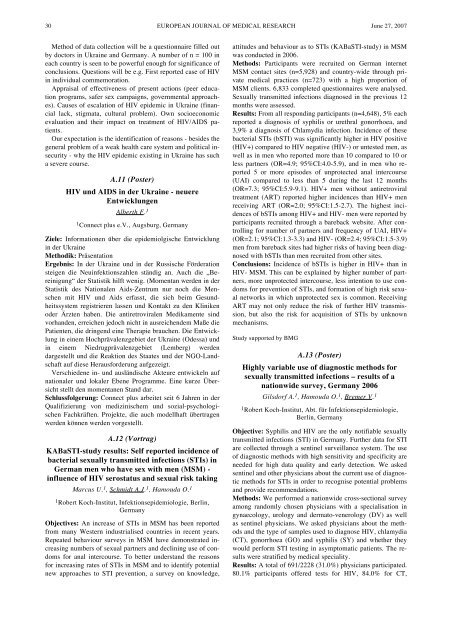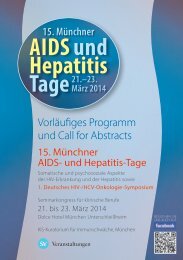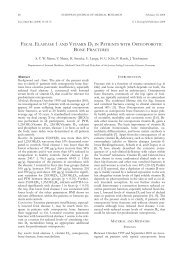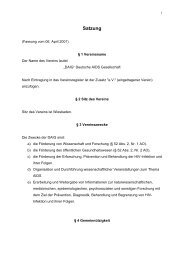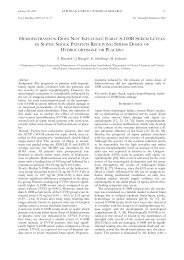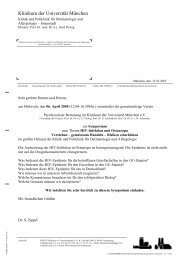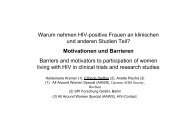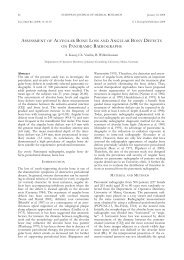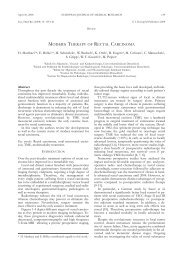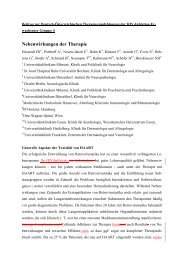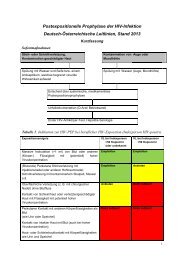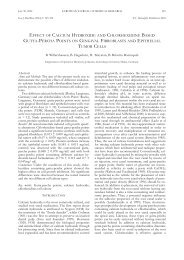European Journal of Medical Research - Deutsche AIDS ...
European Journal of Medical Research - Deutsche AIDS ...
European Journal of Medical Research - Deutsche AIDS ...
You also want an ePaper? Increase the reach of your titles
YUMPU automatically turns print PDFs into web optimized ePapers that Google loves.
30 EUROPEAN JOURNAL OF MEDICAL RESEARCH<br />
June 27, 2007<br />
Method <strong>of</strong> data collection will be a questionnaire filled out<br />
by doctors in Ukraine and Germany. A number <strong>of</strong> n = 100 in<br />
each country is seen to be powerful enough for significance <strong>of</strong><br />
conclusions. Questions will be e.g. First reported case <strong>of</strong> HIV<br />
in individual commemoration.<br />
Appraisal <strong>of</strong> effectiveness <strong>of</strong> present actions (peer education<br />
programs, safer sex campaigns, governmental approaches).<br />
Causes <strong>of</strong> escalation <strong>of</strong> HIV epidemic in Ukraine (financial<br />
lack, stigmata, cultural problem). Own socioeconomic<br />
evaluation and their impact on treatment <strong>of</strong> HIV/<strong>AIDS</strong> patients.<br />
Our expectation is the identification <strong>of</strong> reasons - besides the<br />
general problem <strong>of</strong> a weak health care system and political insecurity<br />
- why the HIV epidemic existing in Ukraine has such<br />
a severe course.<br />
A.11 (Poster)<br />
HIV und <strong>AIDS</strong> in der Ukraine - neuere<br />
Entwicklungen<br />
Alberth F. 1<br />
1 Connect plus e.V., Augsburg, Germany<br />
Ziele: Informationen über die epidemiolgische Entwicklung<br />
in der Ukraine<br />
Methodik: Präsentation<br />
Ergebnis: In der Ukraine und in der Russische Förderation<br />
steigen die Neuinfektionszahlen ständig an. Auch die „Bereinigung“<br />
der Statistik hilft wenig. (Momentan werden in der<br />
Statistik des Nationalen Aids-Zentrum nur noch die Menschen<br />
mit HIV und Aids erfasst, die sich beim Gesundheitssystem<br />
registrieren lassen und Kontakt zu den Kliniken<br />
oder Ärzten haben. Die antiretroviralen Medikamente sind<br />
vorhanden, erreichen jedoch nicht in ausreichendem Maße die<br />
Patienten, die dringend eine Therapie brauchen. Die Entwicklung<br />
in einem Hochprävalenzgebiet der Ukraine (Odessa) und<br />
in einem Niedrugprävalenzgebiet (Lemberg) werden<br />
dargestellt und die Reaktion des Staates und der NGO-Landschaft<br />
auf diese Herausforderung aufgezeigt.<br />
Verschiedene in- und ausländische Akteure entwickeln auf<br />
nationaler und lokaler Ebene Programme. Eine kurze Übersicht<br />
stellt den momentanen Stand dar.<br />
Schlussfolgerung: Connect plus arbeitet seit 6 Jahren in der<br />
Qualifizierung von medizinischem und sozial-psychologischen<br />
Fachkräften. Projekte, die auch modellhaft übertragen<br />
werden können werden vorgestellt.<br />
A.12 (Vortrag)<br />
KABaSTI-study results: Self reported incidence <strong>of</strong><br />
bacterial sexually transmitted infections (STIs) in<br />
German men who have sex with men (MSM) -<br />
influence <strong>of</strong> HIV serostatus and sexual risk taking<br />
Marcus U. 1 , Schmidt A.J. 1 , Hamouda O. 1<br />
1 Robert Koch-Institut, Infektionsepidemiologie, Berlin,<br />
Germany<br />
Objectives: An increase <strong>of</strong> STIs in MSM has been reported<br />
from many Western industrialised countries in recent years.<br />
Repeated behaviour surveys in MSM have demonstrated increasing<br />
numbers <strong>of</strong> sexual partners and declining use <strong>of</strong> condoms<br />
for anal intercourse. To better understand the reasons<br />
for increasing rates <strong>of</strong> STIs in MSM and to identify potential<br />
new approaches to STI prevention, a survey on knowledge,<br />
attitudes and behaviour as to STIs (KABaSTI-study) in MSM<br />
was conducted in 2006.<br />
Methods: Participants were recruited on German internet<br />
MSM contact sites (n=5,928) and country-wide through private<br />
medical practices (n=723) with a high proportion <strong>of</strong><br />
MSM clients. 6,833 completed questionnaires were analysed.<br />
Sexually transmitted infections diagnosed in the previous 12<br />
months were assessed.<br />
Results: From all responding participants (n=4,648), 5% each<br />
reported a diagnosis <strong>of</strong> syphilis or urethral gonorrhoea, and<br />
3,9% a diagnosis <strong>of</strong> Chlamydia infection. Incidence <strong>of</strong> these<br />
bacterial STIs (bSTI) was significantly higher in HIV positive<br />
(HIV+) compared to HIV negative (HIV-) or untested men, as<br />
well as in men who reported more than 10 compared to 10 or<br />
less partners (OR=4.9; 95%CI:4.0-5.9), and in men who reported<br />
5 or more episodes <strong>of</strong> unprotected anal intercourse<br />
(UAI) compared to less than 5 during the last 12 months<br />
(OR=7.3; 95%CI:5.9-9.1). HIV+ men without antiretroviral<br />
treatment (ART) reported higher incidences than HIV+ men<br />
receiving ART (OR=2.0; 95%CI:1.5-2.7). The highest incidences<br />
<strong>of</strong> bSTIs among HIV+ and HIV- men were reported by<br />
participants recruited through a bareback website. After controlling<br />
for number <strong>of</strong> partners and frequency <strong>of</strong> UAI, HIV+<br />
(OR=2.1; 95%CI:1.3-3.3) and HIV- (OR=2.4; 95%CI:1.5-3.9)<br />
men from bareback sites had higher risks <strong>of</strong> having been diagnosed<br />
with bSTIs than men recruited from other sites.<br />
Conclusions: Incidence <strong>of</strong> bSTIs is higher in HIV+ than in<br />
HIV- MSM. This can be explained by higher number <strong>of</strong> partners,<br />
more unprotected intercourse, less intention to use condoms<br />
for prevention <strong>of</strong> STIs, and formation <strong>of</strong> high risk sexual<br />
networks in which unprotected sex is common. Receiving<br />
ART may not only reduce the risk <strong>of</strong> further HIV transmission,<br />
but also the risk for acquisition <strong>of</strong> STIs by unknown<br />
mechanisms.<br />
Study supported by BMG<br />
A.13 (Poster)<br />
Highly variable use <strong>of</strong> diagnostic methods for<br />
sexually transmitted infections – results <strong>of</strong> a<br />
nationwide survey, Germany 2006<br />
Gilsdorf A. 1 , Hamouda O. 1 , Bremer V. 1<br />
1 Robert Koch-Institut, Abt. für Infektionsepidemiologie,<br />
Berlin, Germany<br />
Objective: Syphilis and HIV are the only notifiable sexually<br />
transmitted infections (STI) in Germany. Further data for STI<br />
are collected through a sentinel surveillance system. The use<br />
<strong>of</strong> diagnostic methods with high sensitivity and specificity are<br />
needed for high data quality and early detection. We asked<br />
sentinel and other physicians about the current use <strong>of</strong> diagnostic<br />
methods for STIs in order to recognise potential problems<br />
and provide recommendations.<br />
Methods: We performed a nationwide cross-sectional survey<br />
among randomly chosen physicians with a specialisation in<br />
gynaecology, urology and dermato-venerology (DV) as well<br />
as sentinel physicians. We asked physicians about the methods<br />
and the type <strong>of</strong> samples used to diagnose HIV, chlamydia<br />
(CT), gonorrhoea (GO) and syphilis (SY) and whether they<br />
would perform STI testing in asymptomatic patients. The results<br />
were stratified by medical speciality.<br />
Results: A total <strong>of</strong> 691/2228 (31.0%) physicians participated.<br />
80.1% participants <strong>of</strong>fered tests for HIV, 84.0% for CT,


